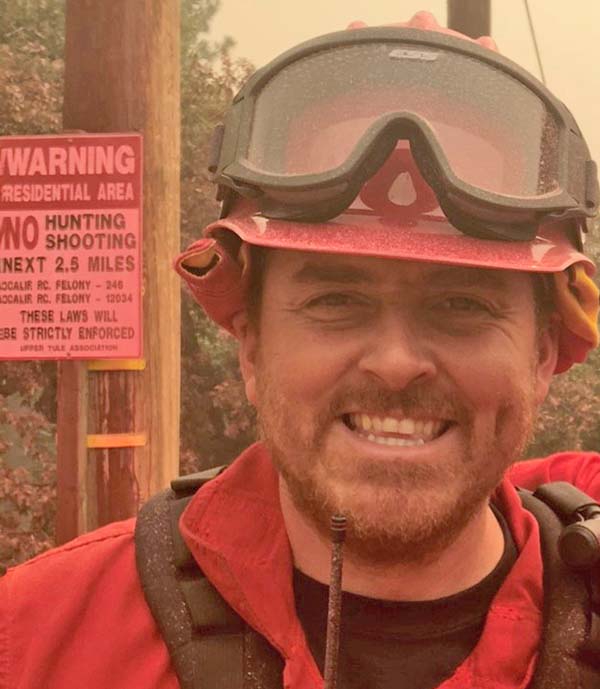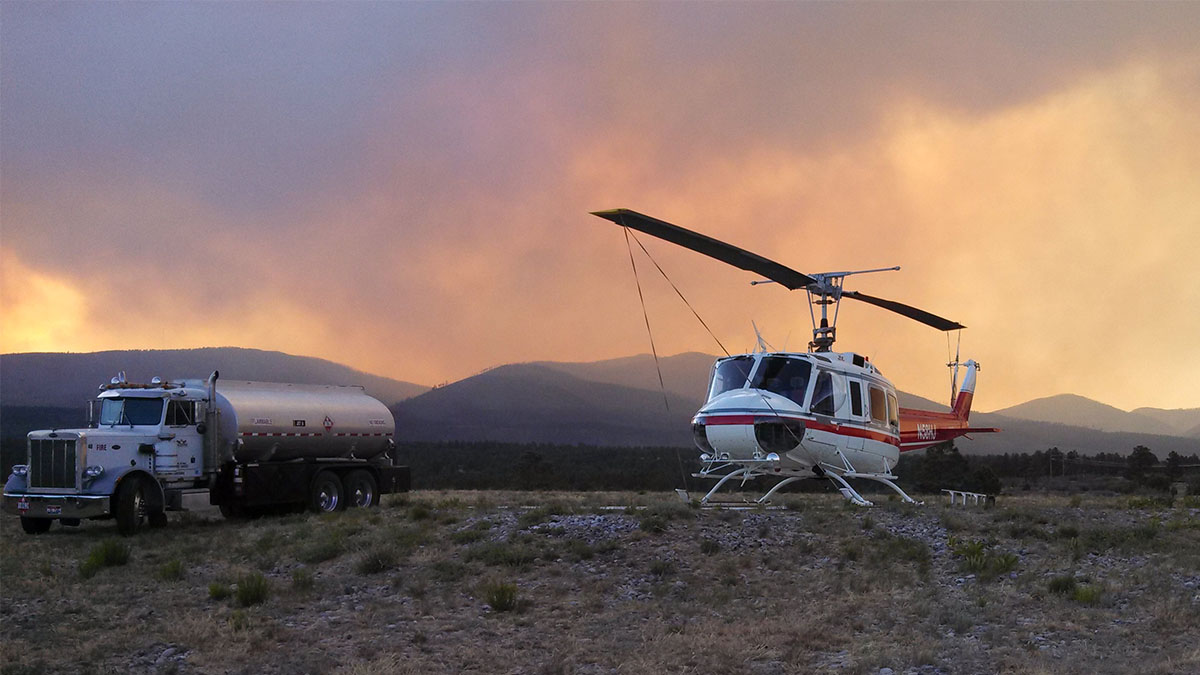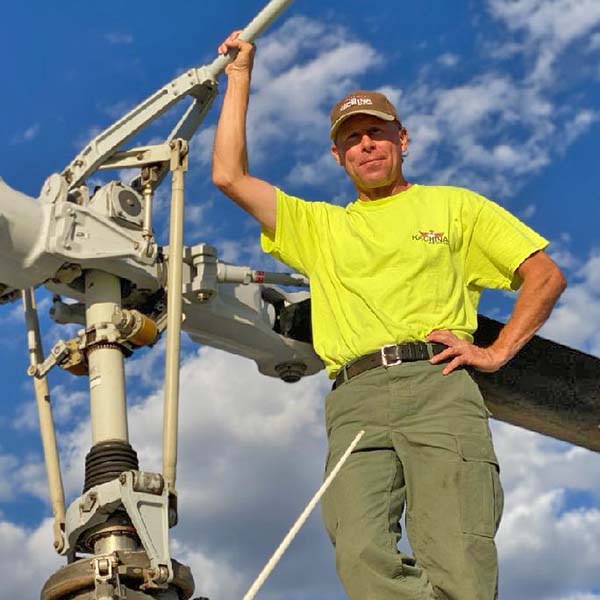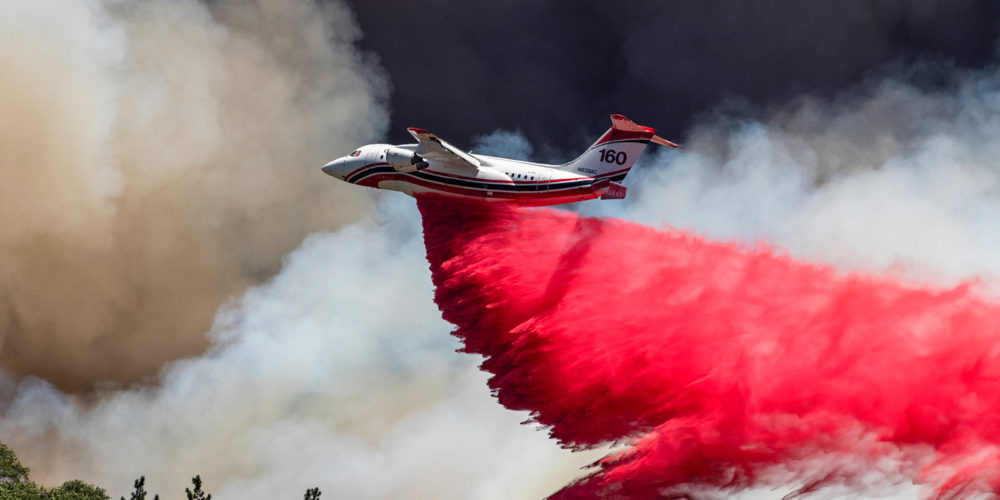It didn’t take long for Jared Testa (’01) to realize just how critical his job was as an airtanker pilot. During his first wildfire season with Aeroflite Aerial Firefighting, as he approached the target drop height of 180 feet from the ground, he saw firsthand one man’s rushed evacuation from the coming natural disaster.
“It was a wildfire in southern California, and it was a breezy day. We got our butt kicked in the turbulence going into this drop, which was basically through a guy’s backyard. As we went over, you could see the guy throwing stuff in the truck to get out of there,” he says. “For me, that was an eye-opener for seeing how serious the job actually is for helping folks on the ground, whether that be firefighters or residents.”
Testa is just one person in an entire network of people — including many Embry-Riddle graduates — involved in providing aerial protection from the increasingly intense wildfire seasons in the western U.S. On that flight in southern California, he dropped 27,000 pounds of fire retardant, but others made the call on where it should go and how it would be leveraged. The retardant is often used indirectly, out in front of a fire, Testa says, but the wildfire may be left to burn up to it and stop on its own, or a ground firefighter might start a backburn at the retardant line, stopping the fire by destroying the fuel in front of it.
“It’s a good challenge to show up and work with the guys and gals on the ground and know that you’re helping them out,” Testa says. “There’s a whole lot of variety, and each mission seems to have a significant amount of difference to it, which I think is what draws a lot of people to the job.”
Connecting the Eagle Pipeline
As a director of admissions at Embry-Riddle’s Prescott Campus, Kurt Estorez (’09) has seen many students inspired to follow in Testa’s footsteps. “The students from out west, a lot of times they’ve seen these planes flying in the summer and that’s what’s driven them to be pilots,” he says.

Estorez draws on that inspiration, as well as their affinity for being up close and personal with airplanes, when he’s looking to fill one of the eight positions at the Prescott Airtanker Base. Though he works in admissions now, he developed an avocation for firefighting as an Embry-Riddle student. A friend offered him a job on the crew at the airtanker base, and he was immediately hooked.
He has spent the last 15 wildfire seasons at the base, mixing concentrated fire retardant on the fly in the right proportion with water when airtankers come in preparing for drops. When they get a call to fill an airtanker, their goal is to get the retardant mix ready and pumping in less than three minutes and to be finished in 10 to 12 minutes, depending on the size of the tanker.
During the 2020 and 2021 wildfire seasons, Estorez worked on firefighting and pumping teams in California and Colorado, sometimes stringing together as many as 10 water tenders — trucks that pump and transport water — to supply water to mix retardant. “We also fill these trucks to apply retardant on the fire line,” Estorez says.
“You’re always faced with unique and troublesome problems out in the middle of nowhere.”
He prefers hiring Embry-Riddle students for his rapid-response “pit crew” at the Prescott Airtanker Base because they bring their sharp eye for airplanes. Even though these aircraft have a rigorous maintenance schedule and sometimes multiple traveling mechanics, members of the airtanker base crew also keep their eyes open for potential issues.
“We tell our crew that if they see something, say something. If something looks abnormal, we can relay it up to any pilot and their crew to come out and double-check it.” Estorez says. “When you see a plane a couple hundred times over a season and you notice something is different, it doesn’t hurt just to mention it. Safety is the biggest aspect of the operation.”

Staying Up and Operational
With safety at the forefront of any aerial firefighting effort, maintenance and repair is a complex undertaking, often requiring ongoing evaluation of several types of aircraft, including helicopters, which offer precision and flexibility in tactical operations.
That’s where maintenance technicians like Shawn Hoem (’00) come in. Near-site helicopter maintenance is critical to safe operation in the heated atmosphere of aerial firefighting.
“What you want is to provide a good aircraft for your crew and your pilot,” says Hoem, who works for Helicopter Express. “I’m constantly managing parts and the arrival of those parts, the aircraft and myself to a particular chunk of ground. The big thing is to keep the aircraft up and operational. I have a philosophy that operations do not wait on maintenance, period.”
Over his last 25 years fixing helicopters, Hoem has always been prepared to replace anything from rotor blades to transmissions and tail booms, sometimes while camped on a closed stretch of road or some other improvised helibase. He’s excelled at the job through his ability to think on his feet. “You’re always faced with unique and troublesome problems out in the middle of nowhere,” he says.
A helicopter is more precise and flexible, but it’s a shorter-range and lower-capacity aircraft than airtankers like the Avro RJ85 that Testa pilots. Hoem’s team will set up a helibase at any practical location within 10 miles of the fire and transport people, water, food and fire-retardant slurry, if necessary, to the target spot. Their goal is always to get it early, with jobs sometimes as small as dousing a single tree. “If the fire gets out of control, we’ll call in the fixed-wing guys. But we try to get ’em small and keep ’em small,” Hoem says.
His Embry-Riddle education in professional aeronautics served him well, even after he discovered his knack for helicopter repair: He bought a Cessna 182 and fitted a jump door so he could use it as a support vehicle when he was a traveling mechanic. He still has the airplane and loves to fly it, but his heart is now in rotorcraft and the high-intensity life of fighting wildfires.
“I can’t imagine a summer not hearing the singsong of an inbound Huey, the beating rotors, the smell of smoke. There’s nothing quite like that,” he says. “I like being right at the point of action, being around the machines, the whole environment of activity. I’m addicted to it like the rest of the guys that are around this stuff. That smoke gets in your blood.”
Find photographer Marty Wolin on Instagram: @eyefolio_photography
